 Image search results - "thatched" Image search results - "thatched" |

Bird's eye view of Shirakawa-go from Ogimachi Castle ruins.
|
|

Side view of Wada-ke House
|
|

Shirakawa-go is also a National Important Traditional Townscape Preservation District (重要伝統的建造物群保存地区).
|
|

Path to Wada House entrance
|
|

Close-up of Ogimachi
|
|

Main house on left and latrine on right with large vats to gather fertilizer.
|
|

Looks like Suganuma, another village in Gokayama area.
|
|
|

Main house with a recently rethatched roof, making it look very smooth.
|
|

Shirakawa-go 白川郷
|
|

Wada House, Shirakawa-go
|
|

Entry road to Ainokura village. Bus stop shelter on right.
|
|
|
|
|

Way to Ainokura.
|
|
|

Gable openings let light and air come through the attic to foster silkworms.
|
|

What you see first is a big parking lot for tour buses. Then you see the hordes of tourists.
|
|

A small stream beside the house helps to melt the snow falling off the roof.
|
|
|

Ainokura monument
|
|
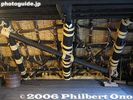
Underside of roof made of an A-frame truss structure
|
|

The thatched roof is replaced every 30 years. Every spring, 6 or 7 thatched roofs are replaced in Shirakawa-go.
|
|

View of Ainokura which is also a National Important Traditional Townscape Preservation District (重要伝統的建造物群保存地区).
|
|

Sugawara house from Tsuruoka city, Yamagata Prefecture. In heavy snow, the front window was used as the door.
|
|
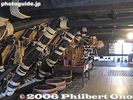
The bottom ends of these beams are pegged into a point (komajiri) resting on another cross beam. Wada House, Shirakawa-go
|
|

It costs several million yen and a small army of workers to replace the thatch. The cost is subsidized by the town, prefecture, and national government.
|
|

View of Ainokura from a hill
|
|

Where silkworms were raised to make silk cocoons.
|
|

Ceiling
|
|
|
|

Kitamura house brought from Hadano, Kanagawa
|
|

Slats on the attic floor to enable smoke and soot from the hearth to reach the attic.
|
|
|

Bird's eye view of Ainokura 相倉展望台
|
|
|
|

Kitamura house
|
|

Straw rope tie the large beams to form a truss for the roof.
|
|
|
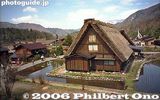
Shirakawa-go 白川郷
|
|

Nihon Minkaen is an outdoor museum of traditional farm and merchant houses with thatched roofs. They have 25 homes from around Japan many were donated to the museum for preservation.
|
|
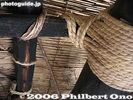
Another rope made of a crushed tree branch to tie smaller beams. It tightens as it dries.
|
|

Ainokura
|
|
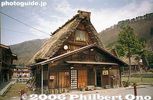
Photo gallery
|
|
|
|
|
|
|
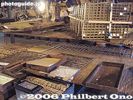
Implements to raise silkworms.
|
|

Restaurant
|
|
|
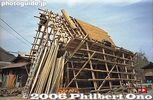
Rethatching a small storehouse.
|
|

Thatched roof
|
|
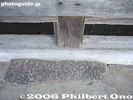
Foundation and pillars rest on stones. The beam is shaped to fit the stone.
|
|

Ainokura
|
|
|
|

Water nozzles aimed at the house. No smoking.
|
|
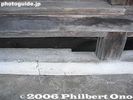
Two foundation beams interlock.
|
|

Ainokura is smaller than Shirakawa-go, but still tourist-driven.
|
|
|
|
|

Thatch repair work.
|
|
|
|
|
|
|
|
|
|
|
|

Yamada house
|
|
|
|
|
|

Center of Ainokura and souvenir shop.
|
|
|
|
|

Thatched roofs
|
|
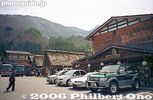
Tourist Information Office in the center of town.
|
|

Emukai house brought from Nanto, Toyama. In the gasshi-zukuri style with steep roof. Kawasaki Nihon Minkaen
|
|

Ainenji temple 相念寺
|
|
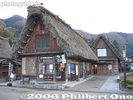
Tourist Information Office
|
|
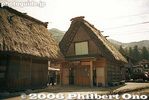
Restroom behind the Tourist Information Office
|
|

Nihon Minkaen, Kawasaki, Kanagawa
|
|

These pictures were taken in the fall.
|
|
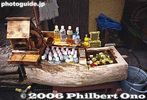
Cooling system
|
|

Inside Emukai house
|
|
|
|
|

Parking lot along the main road through the village.
|
|

Spare thatch, Ainokura
|
|
|
|

Deai Bridge crossing the Shokawa River.
|
|

Center of Ainokura
|
|
|
|
|
|
|

Deai Bridge
|
|
|
|
|

Shokawa River
|
|

Monument in the center of Ainokura.
|
|
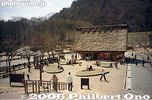
Tourist Info Office near the bus stop.
|
|

Nihon Minkaen, Kawasaki, Kanagawa
|
|
|
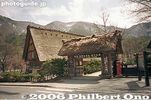
Entrance to the Gassho-zukuri Minka-en outdoor museum.
|
|

Toilet
|
|

Gassho Storehouse 合掌小屋造り
|
|
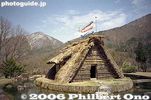
Gassho-zukuri Minka-en outdoor museum
|
|

The museum park has 25 homes from around Japan many were donated to the museum for preservation. Near Mukogaoka-yuen Station on the Odakyu Line. Closed Mon. Admission 500 yen.
|
|
|
|

Gassho-zukuri Minka-en outdoor museum
|
|

Water mill
|
|

Restrooms
|
|
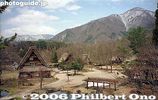
Gassho-zukuri minka houses slated for destruction were moved to this outdoor museum and saved.
|
|

Inside water mill
|
|

Looks traditional on the outside, but modern on the inside.
|
|
|

Hydrangea
|
|

Thatched roof and persimmon tree
|
|
|
|
|
|
|

Fire hydrant
|
|

Fire hydrant
|
|

Manhole in Shirakawa-go.
|
|

Ainokura Folk Museum No. 1 南砺市相倉民俗館1号館Exhibits related to life in Ainokura and the gassho-zukuri houses.
Ainokura Folk Museum 南砺市相倉民俗館
|
|

Shirakawa Village Office
|
|

Ainokura Folk Museum No. 1
|
|
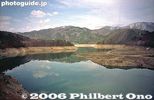
Dam reservoir
|
|
|

Mihoro Dam, made only of rocks and clay. 131 meters high, 405 meters long.
|
|
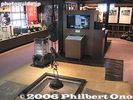
Inside Ainokura Folk Museum No. 1
|
|

Inside Ainokura Folk Museum No. 1
|
|

Inside Ainokura Folk Museum No. 1
|
|

Roof peg
|
|

Old minka house on Mt. Mitake, Tokyo
|
|
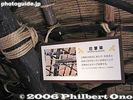
Gassho hari
|
|
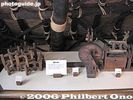
Silk-making implements
|
|
|

Thatched roof
|
|
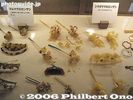
Hair pins
|
|

Mt. Mitake, Tokyo
|
|

Snow coat made of straw.
|
|

Snow outfit
|
|
|
|

Ritto History Museum's minka home on display.
|
|
|

Ritto History Museum's minka home on display.
|
|
|
|

Ritto History Museum's minka home on display.
|
|

Spare thatch
|
|
|

Left side was recently reroofed.
|
|

Ainokura Folk Museum No. 2 南砺市相倉民俗館2号館Exhibits related to the traditional industries of Ainokura such as gunpowder manufacturing and washi paper making.
|
|

Inside Ainokura Folk Museum No. 2
|
|
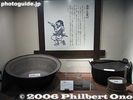
Implements for making gunpowder used in matchlock guns.
|
|
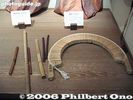
Traditional musical instruments.
|
|
|
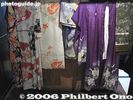
Kimono
|
|
|
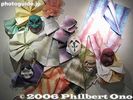
Washi paper
|
|
|

Shrine
|
|

Shrine torii
|
|

Shrine
|
|
|

Monument commemorating the marriage of Crown Prince Hiro (right) and birth of Princess Aiko (left)
|
|
|
|
|

Souvenir of Ainokura
|
|

Road sign showing way to Ainokura.
|
|
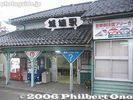
Johana Station
|
|
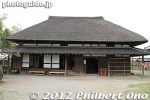
The former Waida home, donated to the park by the Waida family in the early 1980s. Adachi Ward, Tokyo
|
|
|
|
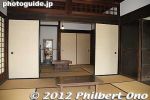
Inside the former Waida home.
|
|
|
|
|
|
|
|
|

About the former Waida home. 和井田
|
|
|
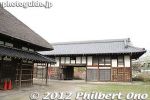
Next to the Waida home is this old gate.
|
|

Behind the Date Kaitaku Kinenkan Museum is the former Mitobe house on display. It is a typical house of the first settlers of Date, Hokkaido. Based on Sendai-style (Miyagi Pref.) architecture. Important Cultural Property. 旧三戸部家住宅
|
|
|

Inside Mitobe house with a hearth.
|
|
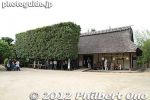
This was the main house of the Koyama estate and the largest building at Kodaira Furusato-mura Village. It dates from the middle Edo Period.
|
|
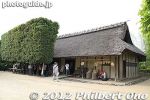
Old Koyama home at Kodaira Furusato-mura Village was originally in Koganei. 旧神山住宅主屋
|
|
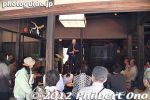
Inside the Old Koyama home at Kodaira Furusato-mura Village. A mini shakuhachi concert was being held when I visited.
|
|

About the Old Koyama home at Kodaira Furusato-mura Village. 旧神山住宅主屋 Web site: http://kodaira-furusatomura.jp/
|
|
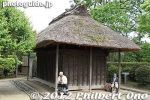
Former Suzuki residence grain storehouse. 旧鈴木家住宅穀櫃
|
|
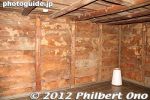
Inside Former Suzuki residence grain storehouse. 旧鈴木家住宅穀櫃
|
|
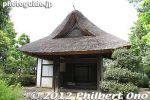
Entrance hall of the former Ogawa residence. This was originally connected to the main house. 旧小川家住宅玄関棟
|
|
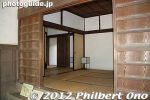
Inside the Entrance hall of the former Ogawa residence. 旧小川家住宅玄関棟
|
|
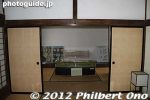
Inside the Entrance hall of the former Ogawa residence. 旧小川家住宅玄関棟
|
|
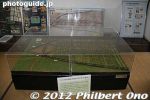
Inside the Entrance hall of the former Ogawa residence. 旧小川家住宅玄関棟
|
|

Illustration of the fomer Ogawa residence in its original state in 1888. 旧小川家住宅玄関棟
|
|
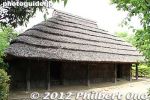
Reconstructed thatched-roof home dating from the early Edo Period. 開拓当初の復元住居
|
|
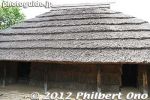
Reconstructed thatched-roof home dating from the early Edo Period. 開拓当初の復元住居
|
|
|
|
|
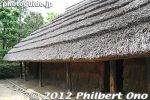
開拓当初の復元住居
|
|
|
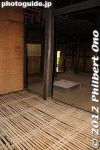
Inside Reconstructed thatched-roof home dating from the early Edo Period. 開拓当初の復元住居
|
|
|
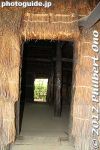
door to the Reconstructed thatched-roof farmer's home dating from the early Edo Period. 開拓当初の復元住居
|
|
|
|
|
|
|
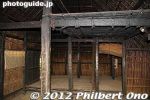
Inside Reconstructed thatched-roof home dating from the early Edo Period. 開拓当初の復元住居
|
|
|
|
|
|
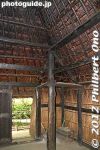
Inside Reconstructed thatched-roof farmer's home dating from the early Edo Period. 開拓当初の復元住居
|
|

About the Reconstructed thatched-roof farmer's home dating from the early Edo Period.
|
|
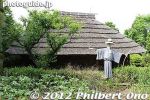
Scarecrow in front of a thatched-roof house.
|
|
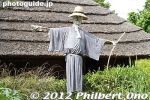
Scarecrow in front of a thatched-roof house.
|
|
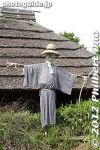
Scarecrow in front of a thatched-roof house.
|
|
|
|
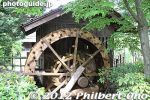
Waterwheel 水車小屋
|
|
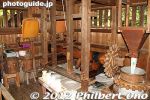
Inside Waterwheel shed. 水車小屋 Web site: http://kodaira-furusatomura.jp/
|
|

Muikara Minka むいから民家園, former farm house with a thatched-roof house originally built in the late 18th century. Free admission.It got in the way of the Odakyu train line (twice) near Komae Station so it was finally moved here in 2002. Open 9:30 am-4:30 pm (till 6 pm in July-Aug.). Closed Wed. and Thu. Address: Moto-Izumi 2-15-5 狛江市元和泉2-15-5, Phone: 03-3489-8981
|
|

The house was originally located near Senryuji temple's front gate. But it got in the way of the Odakyu Line so it was moved in 1927. Then when the station was expanded in 1992, the house was dismantled and put in storage.
|
|

Finally in 2002, the house was moved to and restored at this location. Dirt-floored kitchen with fire stoves. 土間
|
|

Stoves
|
|

Room with a irori hearth 茶の間
|
|
|
|
|

Household Shinto altar
|
|
|

Living room with 10 tatami mats. 座敷
|
|
|

Veranda. The home used to be owned by the Arai family.
|
|

Open 9:30 am-4:30 pm (till 6 pm in July-Aug.). Closed Wed. and Thu. Address: Moto-Izumi 2-15-5 狛江市元和泉2-15-5, Phone: 03-3489-8981
|
|
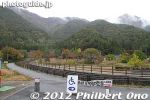
Decided to visit Saiko Iyashi-no-Sato Nenba, an outdoor museum of thatched-roof houses. It is one of the stops on the tourist bus circuit. 西湖いやしの里根場
|
|
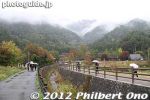
There are five lakes at the northern foot of Mt. Fuji known as Fuji Goko (富士五湖). They are easily accessible by bus from Shinjuku, Tokyo, taking 2-3 hours for around 4,000 yen round trip.
|
|
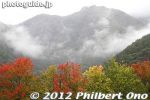
On 2010, Lake Saiko garnered national attention when the native species kunimasu, a type of salmon or black kokanee, thought extinct for 70 years, was discovered in the lake.
|
|
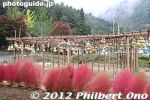
Gourd garden at Lake Saiko's Saiko Iyashi-no-Sato Nenba.
|
|
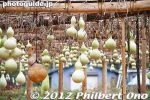
Gourds growing at Saiko Iyashi-no-Sato Nenba. I was soon to find out why they are growing these gourds. (Not for eating.) Whenever I see gourds, it reminds me of Hawaiian hula because they are used as hand drums.
|
|

About Saiko Iyashi-no-Sato Nenba. There used to be a real village here until it was destroyed by a typhoon. Residents moved away, and the village was reconstructed with thatched-roof homes. The museum opened in 2006.
|
|
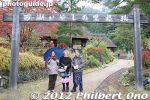
Entrance to Saiko Iyashi-no-Sato Nenba.
|
|
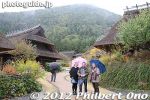
There are mostly tourist souvenir shops selling food and local crafts. One house sold ancient mochi (dark and red colored) and had an irori fireplace. Another house rented samurai armor and kimono to dress up in for only 500 yen.
|
|
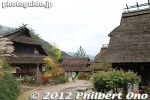
In 1966, a big typhoon bringing heavy rains caused a mudflow that destroyed the homes here, killing 94 residents. The entire settlement was destroyed so the survivors moved to the opposite side of the lake.
|
|
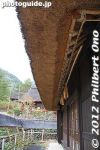
In 2006, they opened this outdoor museum as a testament to the old villagers here. Over the years, they expanded and added more houses. There are now 20 houses.
|
|
|
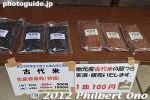
Ancient varieties of rice.
|
|
|
|